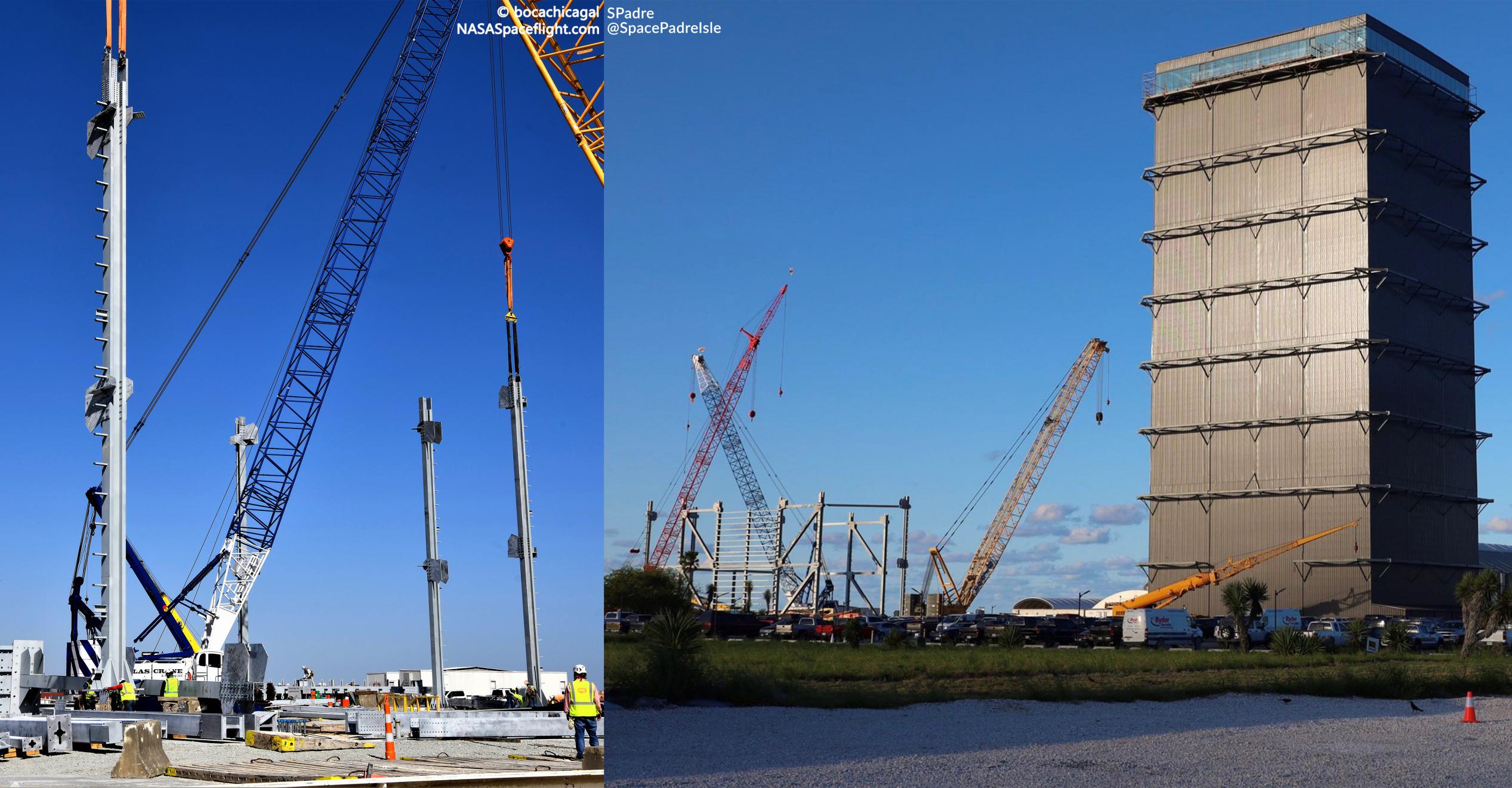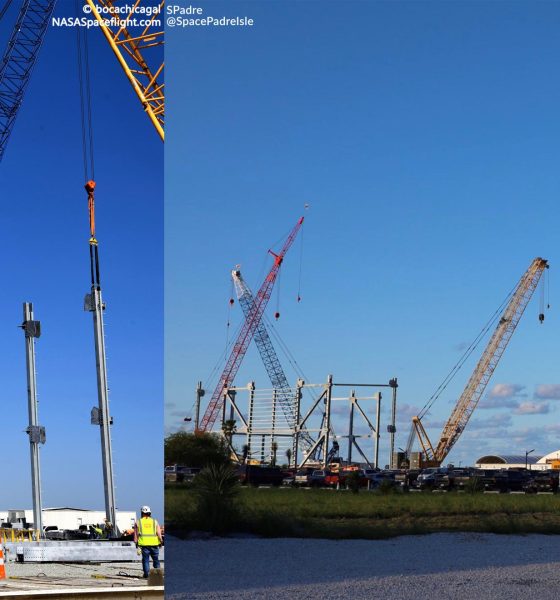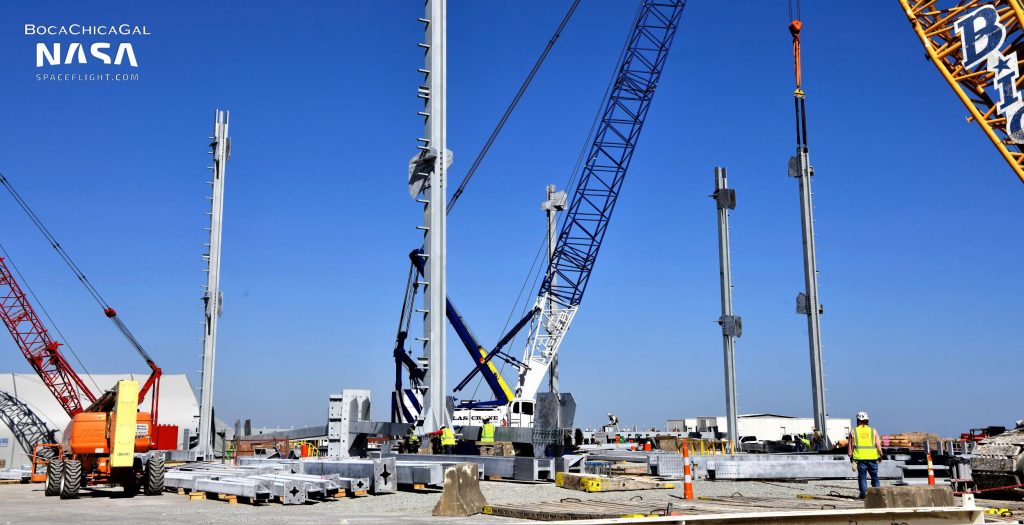

News
SpaceX begins assembling Starbase’s biggest manufacturing building yet
It might not look like much today but SpaceX has begun assembling what is set to become Starbase’s largest Starship manufacturing facility.
The structure, which has generally come to be known as Starbase’s ‘wide bay,’ was first teased by CEO Elon Musk in July 2021 and will be the fourth permanent assembly ‘bay’ constructed at Starbase – currently SpaceX’s sole dedicated Starship factory. The first, now known simply as the windbreak, is a triangular bay built in 2019 that is mostly unused but occasionally supports work on Starship nose assembly. Next, SpaceX built a larger ‘mid bay’ in the first quarter of 2020, out of which every Starship prototype and test tank since SN3 has been built.
A few months after the midbay was finished, SpaceX began constructing an even larger ‘high bay’ around 81 meters (265 ft) tall and 30 by 25 meters (100 by 80 ft) wide – about twice as tall and with twice the area, in other words. While the midbay was specifically optimized for assembling one or two Starship tank sections at a time, the high bay was designed to be large enough to fully assemble one Super Heavy booster (69m/225ft tall) and stack a Starship tank and nose section (50m/165ft tall) at the same time. The goal of SpaceX’s new ‘wide bay’ may be even loftier still.

Though SpaceX’s pace of Starship and Super Heavy assembly and processing appears to have slowed down significantly in the last few months, the company has still proven with Starships SN4-6, SN8-SN11, and SN15-16 that it can build large numbers of suborbital prototypes at the frankly incredible pace of 1-2 per month. With Super Heavy BN1, BN3, and BN3, SpaceX – to a lesser degree – has also demonstrated respectable booster prototype production, though none have flown and only one has completed any testing.
Nonetheless, as SpaceX works to complete Starship S21 and Super Heavy B5 and prepares to begin assembling S22 and B6 while Ship 20 and Booster 4 still sit – largely untested – at the launch site, Starbase’s existing production capabilities are already starting to outstretch its two main assembly bays. In other words, the purpose of SpaceX’s new ‘wide bay’ is almost certainly to double, triple, or even quadruple Starbase’s maximum vehicle production rate.
The wide bay’s dimensions have yet to be officially confirmed but based on aerial views of its foundation, it will measure roughly 50m (~165′) wide, 35m (~115′) deep, and 90-100m (~300-330′) tall, giving it more than twice as much usable floor space as the high bay. In theory, the high bay has enough space for SpaceX to stack 3-4 four Starship or Super Heavy tank sections at once. With more than twice the floor space, the wide bay should singlehandedly allow SpaceX to assemble 3-4 Super Heavy boosters, 4-8 Starships, or 2-3 boosters and 2-3 Starships at once.
At the absolute minimum, once fully outfitted, that means it could roughly triple the number of boosters or ships Starbase can fully assemble each month. Pictured below, there’s also a small but not insignificant amount of evidence (the small rectangles left of the wide bay foundation, bottom right, in the photo above) that SpaceX is completing additional foundation work that could double the wide bay’s floor space yet again. The second 50x35m structure those foundations seem to outline could be a wider midbay, a few-story ring assembly floor to augment Starbase’s tents, a 50x70m ‘high bay,’ or simply a more permanent space for general offices, workshops, storage, and other miscellaneous uses.
Stay tuned for updates on the massive structure’s construction.

Elon Musk
Elon Musk’s X will start using a Tesla-like software update strategy
The initiative seems designed to accelerate updates to the social media platform, while maintaining maximum transparency.

Elon Musk’s social media platform X will adopt a Tesla-esque approach to software updates for its algorithm.
The initiative seems designed to accelerate updates to the social media platform, while maintaining maximum transparency.
X’s updates to its updates
As per Musk in a post on X, the social media company will be making a new algorithm to determine what organic and advertising posts are recommended to users. These updates would then be repeated every four weeks.
“We will make the new 𝕏 algorithm, including all code used to determine what organic and advertising posts are recommended to users, open source in 7 days. This will be repeated every 4 weeks, with comprehensive developer notes, to help you understand what changed,” Musk wrote in his post.
The initiative somewhat mirrors Tesla’s over-the-air update model, where vehicle software is regularly refined and pushed to users with detailed release notes. This should allow users to better understand the details of X’s every update and foster a healthy feedback loop for the social media platform.
xAI and X
X, formerly Twitter, has been acquired by Elon Musk’s artificial intelligence startup, xAI last year. Since then, xAI has seen a rapid rise in valuation. Following the company’s the company’s upsized $20 billion Series E funding round, estimates now suggest that xAI is worth tens about $230 to $235 billion. That’s several times larger than Tesla when Elon Musk received his controversial 2018 CEO Performance Award.
As per xAI, the Series E funding round attracted a diverse group of investors, including Valor Equity Partners, Stepstone Group, Fidelity Management & Research Company, Qatar Investment Authority, MGX, and Baron Capital Group, among others. Strategic partners NVIDIA and Cisco Investments also continued support for building the world’s largest GPU clusters.
News
Tesla FSD Supervised wins MotorTrend’s Best Driver Assistance Award
The decision marks a notable reversal for the publication from prior years, with judges citing major real-world improvements that pushed Tesla’s latest FSD software ahead of every competing ADAS system.

Tesla’s Full Self-Driving (Supervised) system has been named the best driver-assistance technology on the market, earning top honors at the 2026 MotorTrend Best Tech Awards.
The decision marks a notable reversal for the publication from prior years, with judges citing major real-world improvements that pushed Tesla’s latest FSD software ahead of every competing ADAS system. And it wasn’t even close.
MotorTrend reverses course
MotorTrend awarded Tesla FSD (Supervised) its 2026 Best Tech Driver Assistance title after extensive testing of the latest v14 software. The publication acknowledged that it had previously criticized earlier versions of FSD for erratic behavior and near-miss incidents, ultimately favoring rivals such as GM’s Super Cruise in earlier evaluations.
According to MotorTrend, the newest iteration of FSD resolved many of those shortcomings. Testers said v14 showed far smoother behavior in complex urban scenarios, including unprotected left turns, traffic circles, emergency vehicles, and dense city streets. While the system still requires constant driver supervision, judges concluded that no other advanced driver-assistance system currently matches its breadth of capability.
Unlike rival systems that rely on combinations of cameras, radar, lidar, and mapped highways, Tesla’s FSD operates using a camera-only approach and is capable of driving on city streets, rural roads, and freeways. MotorTrend stated that pure utility, the ability to handle nearly all road types, ultimately separated FSD from competitors like Ford BlueCruise, GM Super Cruise, and BMW’s Highway Assistant.
High cost and high capability
MotorTrend also addressed FSD’s pricing, which remains significantly higher than rival systems. Tesla currently charges $8,000 for a one-time purchase or $99 per month for a subscription, compared with far lower upfront and subscription costs from other automakers. The publication noted that the premium is justified given FSD’s unmatched scope and continuous software evolution.
Safety remained a central focus of the evaluation. While testers reported collision-free operation over thousands of miles, they noted ongoing concerns around FSD’s configurable driving modes, including options that allow aggressive driving and speeds beyond posted limits. MotorTrend emphasized that, like all Level 2 systems, FSD still depends on a fully attentive human driver at all times.
Despite those caveats, the publication concluded that Tesla’s rapid software progress fundamentally reshaped the competitive landscape. For drivers seeking the most capable hands-on driver-assistance system available today, MotorTrend concluded Tesla FSD (Supervised) now stands alone at the top.
News
Elon Musk’s Grokipedia surges to 5.6M articles, almost 79% of English Wikipedia
The explosive growth marks a major milestone for the AI-powered online encyclopedia, which was launched by Elon Musk’s xAI just months ago.

Elon Musk’s Grokipedia has grown to an impressive 5,615,201 articles as of today, closing in on 79% of the English Wikipedia’s current total of 7,119,376 articles.
The explosive growth marks a major milestone for the AI-powered online encyclopedia, which was launched by Elon Musk’s xAI just months ago. Needless to say, it would only be a matter of time before Grokipedia exceeds English Wikipedia in sheer volume.
Grokipedia’s rapid growth
xAI’s vision for Grokipedia emphasizes neutrality, while Grok’s reasoning capabilities allow for fast drafting and fact-checking. When Elon Musk announced the initiative in late September 2025, he noted that Grokipedia would be an improvement to Wikipedia because it would be designed to avoid bias.
At the time, Musk noted that Grokipedia “is a necessary step towards the xAI goal of understanding the Universe.”
Grokipedia was launched in late October, and while xAI was careful to list it only as Version 0.1 at the time, the online encyclopedia immediately earned praise. Wikipedia co-founder Larry Sanger highlighted the project’s innovative approach, noting how it leverages AI to fill knowledge gaps and enable rapid updates. Netizens also observed how Grokipedia tends to present articles in a more objective manner compared to Wikipedia, which is edited by humans.
Elon Musk’s ambitious plans
With 5,615,201 total articles, Grokipedia has now grown to almost 79% of English Wikipedia’s article base. This is incredibly quick, though Grokipedia remains text-only for now. xAI, for its part, has now updated the online encyclopedia’s iteration to v0.2.
Elon Musk has shared bold ideas for Grokipedia, including sending a record of the entire knowledge base to space as part of xAI’s mission to preserve and expand human understanding. At some point, Musk stated that Grokipedia will be renamed to Encyclopedia Galactica, and it will be sent to the cosmos.
“When Grokipedia is good enough (long way to go), we will change the name to Encyclopedia Galactica. It will be an open source distillation of all knowledge, including audio, images and video. Join xAI to help build the sci-fi version of the Library of Alexandria!” Musk wrote, adding in a later post that “Copies will be etched in stone and sent to the Moon, Mars and beyond. This time, it will not be lost.”








